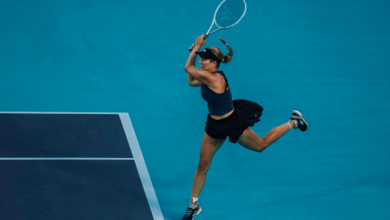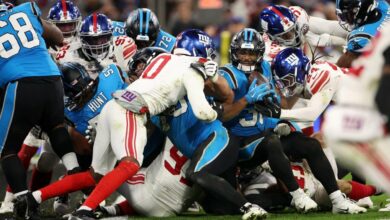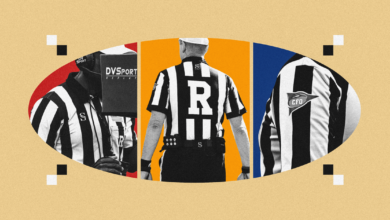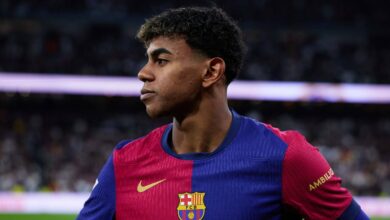Olympic hoops takeaways: LeBron, Steph still have juice; Jamal Murray might not
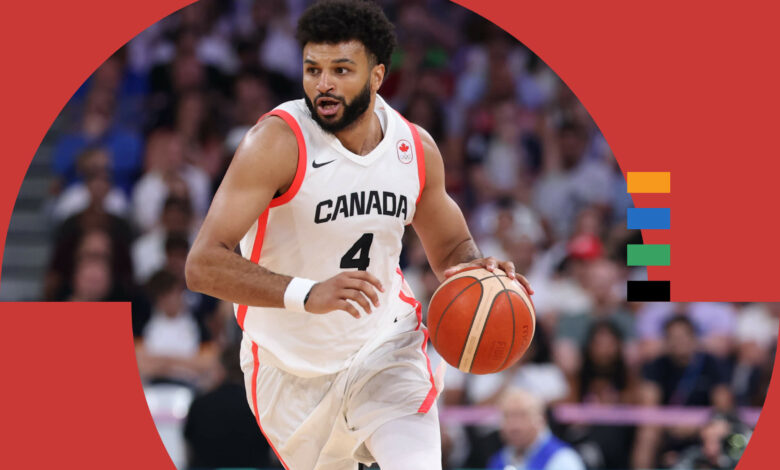
Bon travail, Paris. You did it. Hats off to perhaps the most memorable Olympic basketball tournament (and Olympic Games) ever.
The U.S. men’s basketball team needed all it could muster from its aging (or should we say ageless?) superheroes, and based on the state of their NBA teams, one can fairly wonder if that is the last time any of Stephen Curry, LeBron James and Kevin Durant play in this big a moment again. If so, man, did they go out with a bang.
How about this stat, courtesy of Warriors PR maven Raymond Ridder: Curry had only made four 3-pointers in the final 2:47 of a game once in 1,103 NBA games. Saturday’s gold-medal game was part deux.
STEPH WAS ICE COLD DOWN THE STRETCH. 🥶
Four three-pointers in TWO MINUTES AND 11 SECONDS to close out France for the gold medal. 🥇 #ParisOlympics pic.twitter.com/2dR7UUE0Hn
— NBC Olympics & Paralympics (@NBCOlympics) August 10, 2024
But now, we move on. It’s going to be a big transition for USA Basketball to the next cycle, when Durant, James and Curry are likely to be too old to be of much help. The narrative that the world is catching up is perhaps a little overdone — for one, most of the catching up happened a generation earlier (the U.S. beat Lithuania by just two points in the Olympic semis in 2000). Since the 2004 debacle in Athens, the U.S. is 35-1 in the last five Olympiads.
Nonetheless, the single-elimination format and 40-minute games make for some incredible drama and don’t necessarily guarantee the best or most talented team wins. Spain (2012, 2016) and France (2021 and 2024) have made for worthy adversaries in this format, and Serbia nearly shocked the world in the semifinals. Whomever the U.S. selects to play in 2028 will have to earn their medal; France, in particular, looks set to have a golden generation much like that of the Argentinian group that won gold in 2004.
Everyone is talking about the U.S. vs. France in the 2028 Olympics in Los Angeles, but the next major international competition is the 2027 FIBA World Cup in Qatar. The U.S. owns the Olympics but generally has sent weaker teams to that event; the Americans finished fourth and seventh in the last two World Cups and have only won two of the seven Cups held since 1994.
Ideally, the U.S. will be trying to build a roster for both cycles, but it may prove difficult to do so in back-to-back summers, especially with several likely selections also making deep playoff runs. Our neighbo(u)rs to the north will be trying to do the same thing with their NBA talent, as will the NBA-heavy sides from Australia and France.

GO DEEPER
Can USA Basketball mend fences with Tatum, get younger for L.A. 2028?
That’s all the way in the future, though. For right now, we have an NBA season around the corner, which takes us back to the just-concluded tournament and its connection to the 2024-25 campaign. What can we take away from these past three weeks that has real implications for the coming season? Let’s take a look at 10 big takeaways:
No injuries
When I was on the team side, we always freaked out about players getting hurt playing for their national teams. The reality is there is little correlation between national team minutes and performance declines the following season, and players have plenty of opportunity to injure themselves training for the season, regardless of whether they play in the Olympics.
That said … we made it, everyone. No NBA stars were harmed in the making of these Olympics.
The only notable malady was the Los Angeles Lakers’ Rui Hachimura, who left Japan’s second game with a “left calf injury” that one hopes will be healed by the time camp starts in early October.
Old guys aren’t done yet
Speaking of the Lakers, if you’re a fan of them, the Phoenix Suns or the Golden State Warriors, the Olympics had to leave you feeling a lot better about your team’s prospects than you did in April. Those three squads combined to win one playoff game this past season, and with their key players hitting their late 30s, one can fairly wonder about their respective futures.
However, James, Curry and Durant were Team USA’s three most important players in the medal round, James’ teammate Anthony Davis was the team’s most effective big man, and Durant’s sidekick Devin Booker was quietly awesome in his revamped 3-and-D role.
The Suns already have pushed all their chips in, of course, but the Lakers and Warriors have held back some of their powder. Might these Olympic performances inspire them to go for it one last time while the likes of James and Curry still are capable of elite performances?

GO DEEPER
‘Everything I imagined, and more’: Team USA’s gold medal game seals NBA stars’ legacies
Yabusele makes his mark
Of all the non-NBA players in the tournament, the one who made the biggest impression was French forward Guerschon Yabusele. The 6-foot-8, 275-pound-ish Boston Celtics first-round pick has improved considerably since washing out of the NBA after two years, putting together a strong three-year stretch for Real Madrid and then making his mark in France … including a dunk over James in the gold medal game.
GUERSCHON YABUSELE ON LEBRON JAMES. 😳
📺 NBC and Peacock | #ParisOlympics pic.twitter.com/cjrH6Q9Epd
— NBC Olympics & Paralympics (@NBCOlympics) August 10, 2024
“Oh, he’s an NBA player,” an overseas scout told me. But if Yabusele makes the move, don’t expect it to be this year. A league source confirmed a recent report from NBA reporter Marc Stein that Yabusele has a $2.5 million buyout to leave Madrid this summer, which an NBA team would be on the hook for (and would count against the cap above the $750,000 international buyout maximum) in addition to whatever salary he agreed to.
However, he’s a free agent in the 2025 offseason. Yabusele’s shooting has improved markedly and he’s slimmed down a bit since Boston, both of which make him a more attractive proposition as a stretch four than he was as a Celtic. His defensive awareness was never a strength, but he’s fairly switchable along the perimeter if he’s in shape. Offensively, he’s hit 44.5 percent, 36.1 percent and 40.2 percent from 3 the last three seasons while playing at the highest levels of European basketball and obviously can hammer a mismatch on the block against switches.
For his part, Yabusele seems ready to make the move.
Been waiting for a 2nd chance.. I’m ready 😤🧸
— Guerschon Yabusele (@yabusele28) August 11, 2024
In a disappointing Olympics for Canada, the biggest individual struggle belonged to Murray, the Denver Nuggets guard who battled injuries for most of the second half of last season. Murray’s stats for the tournament are troubling enough — 36.6 percent true shooting and a 4.7 PER — but that maybe could be dismissed as a small four-game sample.
However, Murray didn’t play any better in the exhibitions, and the eye test was troubling. He had no zip, struggling to get separation and failing to explode near the cup in the manner to which we’ve become accustomed. This coming on the heels of a postseason in which he shot just 40.2 percent only adds to the worries. Murray has seven weeks to heal up before training camp starts, but his physical state figures to be a big story in the early part of the season.
There’s another factor at play before the season starts: Murray and the Nuggets seemed en route to agreeing to a four-year, $209 million max contract extension earlier this summer, but Murray has not signed on the dotted line yet. Might the Nuggets be rethinking the wisdom of that commitment?
Bam Ad3bayo?
Another story that may quietly matter for the coming season is Bam Adebayo’s increasing comfort from the 3-point line. Pressed into service as a backup four at times, the Miami Heat star launched nine 3-point attempts in his 97 Olympic minutes, mostly catch-and-shoots from the corner.
That continues a trend line from late last season: Adebayo only had 14 3-point attempts in his first 54 games of the 2023-24 season but launched 38 in his final 22 games, including the playoffs. He made them at a respectable 35.7 percent clip last season. If he can continue at that rate, it can add another dimension to a game that had perhaps become too reliant on midrange jumpers.

Bam Adebayo launches a shot against Canada during an exhibition game in July in Las Vegas. (Candice Ward / USA Today)
Giddey as a leading man
Chicago Bulls fans got their first look at the full-time on-ball version of Josh Giddey, as he ran the point for Australia during the Boomers’ up-and-down tournament. Australia led Serbia by 24 points in the quarterfinals before the game boomeranged (sorry) into an overtime loss; the Aussies also lost to Canada and Greece despite having a deep enough roster that they cut the Portland Trail Blazers’ Matisse Thybulle and deep-sixed Charlotte’s Josh Green from the rotation (zero points in Paris).
Certainly Giddey would have benefited from more spacing on the floor; one reason Australia didn’t need Thybulle and Green was that it already had D-and-notsomuch3 guys such as Dyson Daniels and Dante Exum. However, the Aussies could have really used the Patty Mills and Joe Ingles from five years ago to help open the lane for him. That likely contributed to Giddey’s whopping turnover total (20 in four games), which was the biggest negative in an otherwise solid performance.
Giddey did, somewhat surprisingly, make 11 3-pointers in his four games and shot 50 percent from the floor while carrying a massive 30 percent usage rate. He’ll need to improve his decision-making to become a truly threatening point-of-attack option, but he’ll also have more shooting around him in Chicago.
Houston’s new two-way
Australian forward Jack McVeigh will join the Houston Rockets on a two-way deal, signing just before the Olympics started. Hardcore Cornhuskers might remember him from his three years at Nebraska, but he’s become a much more potent shooter since then, hitting 42.0 percent and 43.4 percent from 3 the past two seasons in Australia’s National Basketball League.
The 28-year-old McVeigh also has a thin frame and may be a bit undersized for an NBA four at 6-8, 215 pounds. He filled his role at the Olympics, making 10 of 19 from 3 in 75 minutes for a shooting-starved Australia team, but him not starting ahead of overseas journeyman Nick Kay hints at some of the defensive limitations he may see at the next level.
A Barrett breakout?
Did anyone south of the border track what RJ Barrett did in his 32 games as a Toronto Raptor last season? If you didn’t, check it out: Barrett averaged 21.8 points and 6.4 rebounds, shot 60.5 percent on 2s and 39.2 percent on 3s and posted a 17.8 PER. After four and a half years of being a meh-efficiency guy barreling to the basket, he was suddenly legitimately good.

GO DEEPER
Canada men’s basketball shows its immaturity as it crashes out of Olympics
That also played out with Team Canada. Barrett was fourth in scoring in the entire Olympic tournament at 19.8 points per game. His 58/44/84 shooting splits added up to 70.1 percent true shooting, and he also averaged nearly two assists for every turnover. He was without a doubt one of the 10 best players in the tournament, and only Canada’s quarterfinal loss kept him off the All-Tournament team.
Given that Barrett is only 24 and should have a ready-made high-usage role waiting for him on a quasi-rebuilding Raptors team, the Olympics only underscored what the second half of last season foretold: Barrett seems like a fairly prominent breakout candidate for the 2024-25 season.
Hope for Micić?
While Green’s play for Australia might not have been terribly inspiring for Hornets fans, the performance of Vasilije Micić was encouraging. He was miscast in Oklahoma City, where the surrounding talent forced him to play off the ball too much, but when he can run a team and play with the ball in his hands, he can make more of an impact.
The 30-year-old guard showed flashes of that in his 30 games with the Hornets at the end of last season, but keep in mind that overseas players often need a year to get their sea legs before flourishing in their second season. With a backup point guard role seemingly waiting for him when he gets to Charlotte, his encouraging play as a floor general for Serbia — he had 14 points and six dimes in the overtime comeback win over Australia and 19 points in 20 minutes in the bronze medal game — offer encouragement.

GO DEEPER
Nikola Jokić leads Serbia to Olympic bronze in men’s basketball over Germany
That still may not justify his $7.7 million salary — Micić still struggles on defense, and his outside shooting comes and goes — but on a Charlotte squad whose only other reliable initiator is the injury-prone LaMelo Ball, his tournament was a positive sign.
Potential pieces
A few other guys marked themselves as players whom scouts will watch more closely this coming season, or circle back on via film for a potential addition later this summer:
- Aside from Yabusele, if there was one former NBA player who made a case to get back in the league in this tournament, it was Canada’s Khem Birch. Originally added to the roster as something of an afterthought on a team with 10 NBA players, he ended up being the Canadians’ most effective big man. Birch turns 32 in September and only played 12 games last season (for Spanish squad Girona), but based on his play in the Olympics (and the tune-up games), teams needing a third center should be calling.
- The New York Knicks own the rights to Mathias Lessort, the athletic French forward who had a solid tournament and is signed with Greece’s Panathinaikos for the coming season. Lessort can’t shoot, however, and at 6-9 is undersized to play the middle at the NBA level. He turns 29 in September and could be a last-resort option for New York next offseason if the Knicks can’t fill their backup center hole.
- The Atlanta Hawks drafted Isaïa Cordinier in 2016, but he is a free agent for NBA purposes after the Brooklyn Nets opted not to tender him in 2021. He had a middling year in Italy this past season but broke out with 43 total points in the quarterfinals and semifinals against Canada and Germany; he ended up leading the French team in PER for the tournament. He’s signed for the coming season with Virtus Bologna.
- Serbian defensive pest Aleksa Avramović — the defensive player of the tournament after nabbing 10 steals in just 119 minutes — just signed a new deal with CSKA Moscow and may not be offensively gifted enough to be more than a bit player in the NBA. He’s also making enough money that a two-way deal wouldn’t make financial sense. At 29, he’s a bit long in the tooth for an import, but scouts will be tracking him.
- France’s Matthew Strazel fell out of the rotation in the medal round, but the 23-year-old Monaco guard will have eyes on him after he went undrafted in June, especially if he’s open to serving on a two-way in 2025-26. Strazel is only 6-0, and his shooting runs hot and cold, but his defense and quickness could allow him to become a backup-caliber point guard if he can keep upgrading his skill level.
- Germany got a strong tournament from forward Isaac Bonga, who played for Bayern Munich last season and is currently unsigned. Bonga played in the NBA for the Lakers, Wizards and Raptors. His lack of offensive punch ultimately shoved him out of the league, but he’s only 24. The 6-8 forward still has a pathway back as a 3-and-D guy, even if it’s a couple years down the road, if he can shoot as consistently as he did in Paris (14 of 24 in six games).
- South Sudan guard Carlik Jones signed with Partizan Belgrade in Serbia for the coming season; he’s undersized at 6-0, but the former G League MVP’s ability to create shots could see him fill a second-unit creator role at the NBA level. In eight games for South Sudan over the last two summers, he averaged 19.5 points and 9.4 assists on respectable 47/37/79 shooting splits; he also had a triple-double against the U.S. in an exhibition game South Sudan lost by a point.
Required Reading
(Top photo of Jamal Murray: Gregory Shamus / Getty Images)

